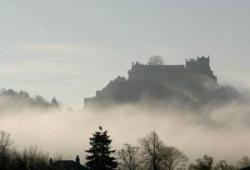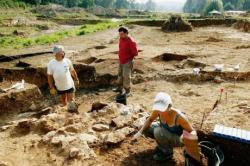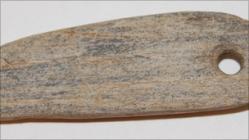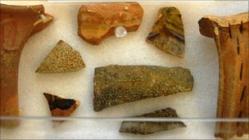- 26 MAI
- ROYAUME-UNI –  Stirling Castle - Some of the most horrific war-related injuries ever found have been identified by scientists studying the remains of medieval warriors killed in Scotland's wars of independence. One individual died after suffering 100 fractures, showed a study at Bradford University. Others had between seven and 16 fractures, all caused by massive blunt force, rather than bladed weapons. Although the skeletons, from Stirling Castle, 40 miles north-west of Edinburgh, were all discovered in the 1990s, identification and detailed scientific analysis of the injuries was done over the past 18 months. It is likely that the nine individuals – including five men, a woman and an infant – were killed during two or more of the eight sieges of Stirling Castle between 1296 and 1342. The Battle of Bannockburn a mile away was fought primarily for control of the fortress. The precise cause of most of the victims' injuries is not yet known. But many of them may have been sustained through siege warfare. The fact that they were buried inside the castle, rather than elsewhere, suggests that they were under siege at the time. The blunt force damage is consistent with the sort of injuries which would have been sustained at the receiving end of a medieval artillery barrage of rocks, unleashed by great siege engines. It is known, for instance, that Edward I (nicknamed Hammer of the Scots) developed a giant trebuchet – a vast wooden catapult – to bombard Stirling Castle. Indeed, in 1304 he drove the Scottish defenders who had already surrendered, back into the castle to suffer as "guinea pigs" at the receiving end of the outsized machine known as Edward's "War Wolf". But it is also possible that some of the individuals were systematically beat and killed, or that they were trampled by horses in the thick of battle. But the almost complete absence of sword damage on the skeletons probably makes those latter explanations less likely. Facial reconstructions of two of the individuals – the woman and one of the male warriors – will go on display at Stirling Castle early next month. But only further research will determine whether the victims were Scottish or English soldiers, because the castle changed hands eight times in 46 years in the late-13th and mid-14th centuries. Today's castle dates from the 16th century, but the masonry was re-used from medieval fortifications. The skeletons were in the medieval royal chapel. The individuals' interment there – an unusual act – suggests not only that it was under siege conditions when burial elsewhere was impossible, but also that the individuals were of high status.
Stirling Castle - Some of the most horrific war-related injuries ever found have been identified by scientists studying the remains of medieval warriors killed in Scotland's wars of independence. One individual died after suffering 100 fractures, showed a study at Bradford University. Others had between seven and 16 fractures, all caused by massive blunt force, rather than bladed weapons. Although the skeletons, from Stirling Castle, 40 miles north-west of Edinburgh, were all discovered in the 1990s, identification and detailed scientific analysis of the injuries was done over the past 18 months. It is likely that the nine individuals – including five men, a woman and an infant – were killed during two or more of the eight sieges of Stirling Castle between 1296 and 1342. The Battle of Bannockburn a mile away was fought primarily for control of the fortress. The precise cause of most of the victims' injuries is not yet known. But many of them may have been sustained through siege warfare. The fact that they were buried inside the castle, rather than elsewhere, suggests that they were under siege at the time. The blunt force damage is consistent with the sort of injuries which would have been sustained at the receiving end of a medieval artillery barrage of rocks, unleashed by great siege engines. It is known, for instance, that Edward I (nicknamed Hammer of the Scots) developed a giant trebuchet – a vast wooden catapult – to bombard Stirling Castle. Indeed, in 1304 he drove the Scottish defenders who had already surrendered, back into the castle to suffer as "guinea pigs" at the receiving end of the outsized machine known as Edward's "War Wolf". But it is also possible that some of the individuals were systematically beat and killed, or that they were trampled by horses in the thick of battle. But the almost complete absence of sword damage on the skeletons probably makes those latter explanations less likely. Facial reconstructions of two of the individuals – the woman and one of the male warriors – will go on display at Stirling Castle early next month. But only further research will determine whether the victims were Scottish or English soldiers, because the castle changed hands eight times in 46 years in the late-13th and mid-14th centuries. Today's castle dates from the 16th century, but the masonry was re-used from medieval fortifications. The skeletons were in the medieval royal chapel. The individuals' interment there – an unusual act – suggests not only that it was under siege conditions when burial elsewhere was impossible, but also that the individuals were of high status.
http://www.independent.co.uk/news/uk/this-britain/skeletons-tell-tales-of-brutal-wars-from-beyond-the-castles-crypt-2289707.html
- FRANCE –  Bergerac – Creysse - Les fouilles deviennent systématiques et les maires de Bergerac et Creysse cherchent une solution face à des particuliers et des promoteurs découragés. Tout le monde n'a pas la passion du silex maestrichtien au point de se demander si l'industrie lithique bergeracoise existait avant l'acheuléen, alors qu'on pensait juste débattre de la couleur des volets. Mais à Bergerac, dont le sous-sol est riche, la perspective de voir creuser des archéologues sur le chantier de sa maison est grand. Six mois d'attente pour un diagnostic, plusieurs mois de fouilles s'il est « positif », en moyenne, et jusqu'à deux ans d'attente en cas d'étude approfondie : il y a de quoi se dédire d'un achat foncier ou retirer un permis de construire. D'où l'idée des maires de Creysse et Bergerac de créer un service archéologique commun, censé raccourcir les délais de diagnostic. Entre les rives de la Dordogne et La Cavaille, les deux rives du centre-ville, les lieux dits des Réclaussous et de la Mérille (rive gauche), le secteur de Pécharmant sur les hauteurs, celui des tabacs dans la vallée ou le barrage ouest les pieds dans l'eau : toutes ces zones sont « à risque » (définis par le Service régional de l'archéologie). C'est-à-dire qu'elles sont systématiquement soumises à un diagnostic.
Bergerac – Creysse - Les fouilles deviennent systématiques et les maires de Bergerac et Creysse cherchent une solution face à des particuliers et des promoteurs découragés. Tout le monde n'a pas la passion du silex maestrichtien au point de se demander si l'industrie lithique bergeracoise existait avant l'acheuléen, alors qu'on pensait juste débattre de la couleur des volets. Mais à Bergerac, dont le sous-sol est riche, la perspective de voir creuser des archéologues sur le chantier de sa maison est grand. Six mois d'attente pour un diagnostic, plusieurs mois de fouilles s'il est « positif », en moyenne, et jusqu'à deux ans d'attente en cas d'étude approfondie : il y a de quoi se dédire d'un achat foncier ou retirer un permis de construire. D'où l'idée des maires de Creysse et Bergerac de créer un service archéologique commun, censé raccourcir les délais de diagnostic. Entre les rives de la Dordogne et La Cavaille, les deux rives du centre-ville, les lieux dits des Réclaussous et de la Mérille (rive gauche), le secteur de Pécharmant sur les hauteurs, celui des tabacs dans la vallée ou le barrage ouest les pieds dans l'eau : toutes ces zones sont « à risque » (définis par le Service régional de l'archéologie). C'est-à-dire qu'elles sont systématiquement soumises à un diagnostic.
http://www.sudouest.fr/2011/05/26/la-richesse-prehistorique-freine-l-envie-de-batir-409102-633.php
- FRANCE – Tours – Des fermes gauloises étaient installées à Tours nord, là où l'on va établir le centre de maintenance du tramway et le parking, le long du boulevard Abel Gance. Les fouilles, obligatoires avant la mise en route du chantier, portées par le Sadil (service départemental d'archéologie d'Indre et Loire) et l'Institut national de l'archéologie préventive se sont étalées sur 4 mois. Les premiers résultats scientifiques de ces fouilles ont été présentés samedi dernier à l'Hôtel du département, par Jean-Marie Laruaz, archéologue responsable. Le chantier s'étend sur 9 ha et le travail des archéologues, une quinzaine, a concerné 4,5 ha.
Après avoir décapé le sol sur 40 cm, ceux-ci ont mis en évidence les trous des poteaux de bois d'une vingtaine de bâtiments, construits à l'époque en paille et en terre, révélant deux établissements agricoles du II e siècle avant JC, ainsi que les fossés entourant ces lieux dans lesquels les occupants avaient jeté poteries cassées et divers objets. Après 1.000 relevés, autant de fiches et 40 caisses de trouvailles, le travail des scientifiques a commencé pour faire parler toutes ces traces. Les céramiques d'avant notre ère, des restes d'amphores venues d'Italie, des monnaies du I er siècle avant JC, quelques ossements, des outils, mais aussi des pollens et des graines qui permettront de reconstituer l'environnement des fermes.
On peut d'ores et déjà tirer quelques conclusions : on pratiquait des activités de filage et de tissage, ce qui impliquait sans doute l'élevage de moutons ; des fragments de meule attestent la présence de céréales et la production de farine ; des scories de fer montrent que le sous-sol (encore aujourd'hui) permettait de produire du fer ; l'importance de la vaisselle permet d'envisager production et stockage importants... Le travail des spécialistes pour exploiter tout ce qui a été trouvé ne fait que commencer.
http://www.lanouvellerepublique.fr/LOISIRS/Patrimoine-tourisme/Le-tramway-chez-les-Gaulois
- INDE - Mahbubnagar - The department of archaeology has recently retrieved a treasure trove comprising copper and silver coins and silver jewellery that dates back to the 20th century. Officials of the department said that the trove was found while digging an old house in Mahbubnagar district and contains 737 copper coins (of two anna denomination), 36 silver coins that belonged to the last Nizam, Osman Ali Khan, silver ornaments, one silver `kadiyam' (bracelet), a silver `patti' (anklet) and a silver waist belt. Besides Mahbubnagar, the department has also received similar coins from Khammam and Vijaynagaram in the recent past, officials said.
http://timesofindia.indiatimes.com/city/hyderabad/Nizam-era-coins-found-in-Mahbubnagar/articleshow/8575451.cms
- ROYAUME-UNI – 
 Longstanton - The dig is in the village of Longstanton which is in an area that has already thrown up Iron Age, Roman, Saxon and mediaeval finds. A team from Birmingham University are carrying out the dig before house building begins. Pottery, bone and stone tools have recently been found at the site. This most recent dig has uncovered an Iron Age enclosure. The enclosure contains internal structures, rubbish pits and granaries from the Iron Age settlement.
Longstanton - The dig is in the village of Longstanton which is in an area that has already thrown up Iron Age, Roman, Saxon and mediaeval finds. A team from Birmingham University are carrying out the dig before house building begins. Pottery, bone and stone tools have recently been found at the site. This most recent dig has uncovered an Iron Age enclosure. The enclosure contains internal structures, rubbish pits and granaries from the Iron Age settlement.
http://www.bbc.co.uk/news/uk-england-cambridgeshire-13560004